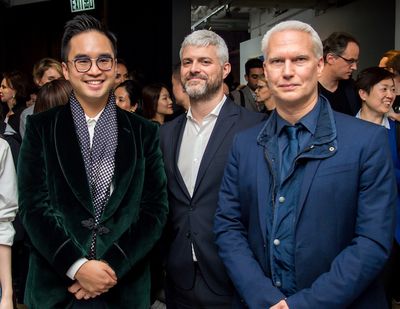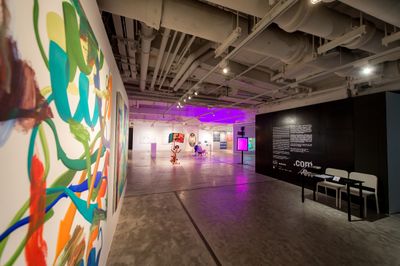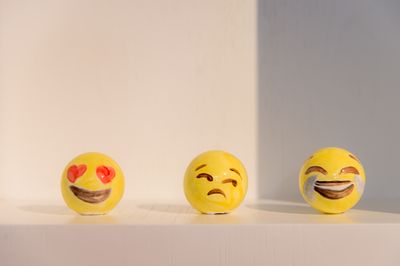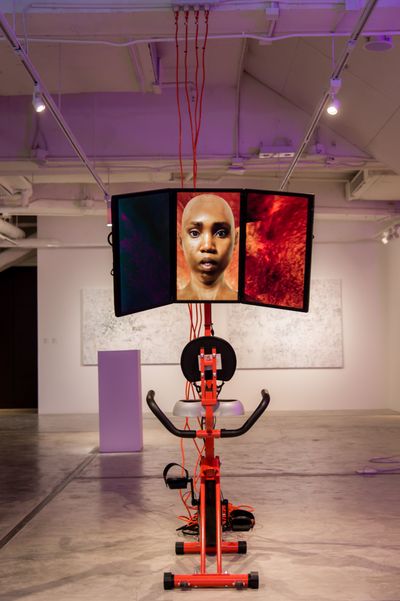Peter Eleey and Klaus Biesenbach
Adrian Cheng, founder of K11 Art Foundation with .com/.cn curators Peter Eleey and Klaus Biesenbach. Courtesy K11 Art Foundation.

Adrian Cheng, founder of K11 Art Foundation with .com/.cn curators Peter Eleey and Klaus Biesenbach. Courtesy K11 Art Foundation.
One of the pressing threads of curatorial thinking over the last decade has attempted to draw together the ideological stakes of technology with the political realities of globalisation and post-colonialism.
These relationships have been articulated in compelling ways in the work of critics and curators like Omar Kholeif, Orit Gat, and Karen Archey, but the exhibition history of this genre is actually quite misleading: most high-profile exhibitions tend to focus either on specific regionalisms or on the digital as a universal or cosmopolitan space.
Fortunately, this is changing with a new rash of exhibitions that set out to trace the complex dynamics of messy hierarchies and identities graphing themselves into the often-indeterminate territories of the virtual.
Hong Kong's K11 Art Foundation has encouraged this turn with a series of shows in which voices from greater China are made a necessary component of the story of internet culture, including After Us at chi K11 art museum in Shanghai, curated by Lauren Cornell of the New Museum (17 March–31 May 2017), and .com/.cn at the K11 Art Foundation Pop-up Space in Hong Kong, curated by Klaus Biesenbach and Peter Eleey of MoMA PS1 (21 March–30 April 2017).
On the occasion of the latter exhibition's opening, which presents 15 artists including Cao Fei, DIS, Darren Bader and Li Ming, Ocula spoke with Eleey and Biesenbach about the geographies and genders of network thinking.
Let's start out with some of the things you have said about painting being so central to .com/.cn, a project that is nominally more about the digital. Liang Wei is the only Chinese painter in a small group of artists in the exhibition working in the medium. How does she fit alongside artists like Laura Owens and Gregory Edwards?
Peter Eleey: With Liang Wei, the schematic abstraction of these paintings [in the show] and the source material she uses and shifts between has an odd relation to her smaller, earlier paintings. But she talks about that process of structuring the paintings—this idea that you or, ideally, the abstraction, could allow the painting to be more internally focused; that it doesn't have to rely on reference to things outside itself. Think of another painter working this way, like Julie Mehretu. In those early schematic paintings of Julie's, you feel like you recognise things from outside in the world: you're looking for and grasping at forms, and, as a result, the paintings have this feeling of the world scrambled and chaotically represented. I remember seeing her paintings in Istanbul in 2003, and people would say, 'Oh, look, it's a perfect description of East and West, like Istanbul', and then a year later you'd be in São Paulo and they'd look at the same paintings and say, 'Oh, it's a perfect representation of the traffic here'. There was a looseness and yet specificity to the formal vocabulary in those paintings that seemed tied to the world in some way. I thought Liang Wei's description of her work dispensing with that so that it could become a more complete world unto itself was interesting and seemed, in some ways, reflective of Chinese cultural policy. It wasn't necessarily that her paintings were technology paintings, but their form of reference and description seemed related to the kinds of thinking that I think we're finding elsewhere.
Gregory Edwards obviously has the smudge vocabulary in his paintings—on some level sort of cyber-smudgy and, on another level, de Kooning-smudgy. It's that idea of a contemporary painting, in quotes and not in quotes, that is looking at a very specific touchstone in the Western painting tradition, while Liang Wei is using structures and certain kinds of formal vocabulary from Song dynasty painting. There is this other system of historical reference within which contemporary language is being deployed. I was thinking about the two of them together. Laura Owens is different even though she has a smudginess to her work, too. She's a super analogue painter, in the way that the low-res image intersects with the actual technology of the silkscreen, of the fabric itself. You end up with these moments in her work where these two systems interact with each other in the image itself. The little emojis are another example: there are interesting frictions between the digital and the analogue in her work which then dovetails with Edwards's paintings of the world recognisably and not recognisably piled up on itself.
I thought Liang Wei was an interesting outlier, because most of the other Chinese artists are more literally working in this digital technology vocabulary. Were you interested in looking more particularly for a certain type of practice from the Chinese artists?
PE: I tend to always look away from whatever the subject is—I think form is usually the truest in that direction. But I still have the sense that the work of younger women artists working with technology, or at least influenced by it, is very specific and different. At one point, all of the Chinese artists in the show were women. I don't know enough to speculate why that is. I guess, from a Western perspective, it has something to do with the liberation from traditional gender roles that technology provides.
Then again, Lin Ke has a video in that show that is similar to Liang Wei's painting, in a weird way. It's like this bizarre hermetic system in which you're looking at this piece, and he's showing you the video on the same laptop where he recorded it, so you see his reflection over his recorded reflection. There's this system collapsing in on itself, a hall of mirrors chasing the image of the thing. And that felt like an internally referential structure of the work, which became an analogue or corollary to Oliver Payne's painting. There is also a hall of mirrors aspect to Oliver's portal paintings—the painter painting himself: there's that sort of ouroboros aspect of it.
You've mentioned previously your low of opinion of the vocabulary of post-internet art. This exhibition seems to avoid that group of artists entirely, in addition to the word itself.
PE: Sondra Perry is interesting in this respect, because the avatar element present in the work of other artists who I love, like Ed Atkins, turns away from this overwhelmingly male aspect—male angst in virtual form. With Cao Fei it is different because the avatar of China Tracy is a fantasy projection, but Perry takes that into the realm of the contemporary black body in the United States during a period of violence that becomes social media spectacle. The piece is her talking about this: she's kind of heavyset, and she describes how the tools that are available for representing herself in the digital sphere don't match her body—that gap between the idealised digital space and the reality of the artist's body, our bodies. And then she has this exorcism in the middle of it, which she talks about as expelling what mainstream white culture has historically placed onto blackness. Take the green screen, which Mark Leckey and others take for granted as a backdrop for thinking about a range of other things. In Sondra's hands, the green screen actually becomes an interesting way to think about the abstraction and unreality at the core of racial inequality in the US. Setting that up now in relation to Cao Fei's China Tracy project seemed interesting.
Looking at the Chinese artists included in this exhibition or the research for this exhibition, are there any practices that you find particularly striking, or that may have surprised you in the preliminary research?
Klaus Biesenbach: I only do solo shows for artists I find striking or relevant per se, not based on nationality. With Cao Fei it was clear that she was incredibly influential in her generation. Even in this exhibition I think it is clear that it is not a thematic exhibition based on China, but rather topical. In the research I would always ask a series of questions in my studio visits, especially, 'Which websites do you use?' On my first batch of studio visits in August 2015, we did 50 studio visits in Beijing and posted pictures and everybody commented, 'Wow, the sky is so blue'. And then two weeks into that research, somebody explained to me that is was because there was a military parade coming, and that coincided with the world athletics championships, so it was a completely non-representative state. They closed all the factories, the sky was blue, and the internet was accessible because all the athletes were in town. It's a topical show because none of that limited or defined our research, but imprinted our research because it was our daily reality.
For sure it seems the digital worlds are creating a map that overlaps with geopolitical realities, but also kind of pushes us into a different direction. They're never contiguous, which is why it's interesting to produce these aesthetic forms for that digital world—you can put weight into it and move the needle one way or another.
KB: There's a time delay. We were at Beijing's Sishang Museum yesterday, where we watched two major works by Ryan Trecartin, and they looked so different in this environment. And you had Mark Leckey and Ed Atkins, a series of great pieces. We've seen one Trecartin piece in Berlin and the other in New York, but still it looked so different here. It's amazing how two or three years just totally change the perception.
PE: The show that Trecartin did last year at Andrea Rosen [with Lizzy Fitch (19 March–20 April 2016)] really felt like a sort of boding, Midwestern thing. It felt very Trumpian in a way—very capital-A America. A premonition. And maybe it's just because I've spent some time living in the Midwest, but it seemed somehow even more that way here. In a sense we have been using this internet context as a shorthand for trying to think about forms of exhibition making and ways of thinking about art, starting to reference and give form to these rapidly shifting geopolitical realities that constrain and limit art making and image circulation, but, at a certain point, also give it some kind of ground against which to react. It's funny to me that there are very few shows that have taken this on so explicitly, pretty much just Art Post-Internet that you and Karen Archey curated [at Ullens Center for Contemporary Art, Beijing (1 March–11 May 2014)], and Speculations on Anonymous Materials [at Fridericianum, Kassel (29 September 2013–26 January 2014)], curated by Susanne Pfeffer. Maybe there will be more of a transnational effort. —[O]












































































































































































